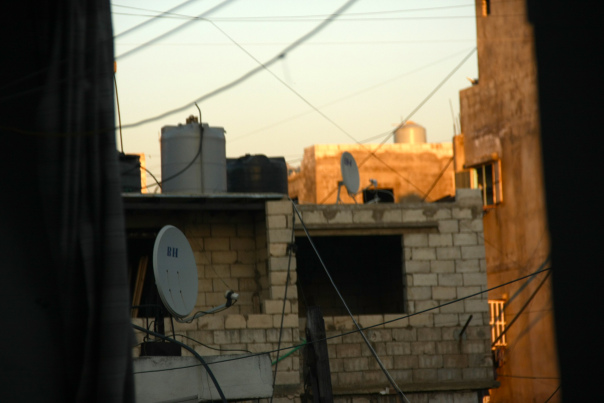The following piece is reblogged from imik simik, the blog of LEAP volunteer Ann. Ann’s blog contains a number of other entries dedicated to her time in Shatila, and we encourage you to visit and read them all!
The nearer my departure draws, the faster the time passes. Today, the series on senses in Shatila continues (see also entries on sight, smell, and feeling, and get ready for tasting soon) with hearing.
And so, a brief litany of just a few components of the soundscape of Shatila:
First are the many families who seemed so much closer to me than the neighbors in my studio apartment in Washington ever did. Thinking back on my life in Washington, everything seems sterile and muffled in comparison to Shatila, where through thin cinderblock walls and across the alleyways we could reach across with just an arm out the window, we heard babies wailing, parents lecturing, television news reports and Hollywood movies piped in via satellite dishes, and, of course, the music – the constant music, some variety of dancepopboomboom music – played all night long and entirely too loudly from some guy’s cell phone.
Then there were the transcendental sounds we were treated to at a concert given by Huda Asfour at the Beirut Center for the Arts (not Shatila, true, but such a markedly different experience from the sounds of Shatila that it haunted me all the way back to the camp). The music itself was as soothing and calming and uplifting even as the content of the lyrics ranged from love poetry to the wrenching Yasmine (mentioned in the linked article), written during the second Intifada.
The best line of the night, however, was delivered as our lost and exasperated taxi driver pulled over to ask a few men sitting around in boxers and tank tops (they were car mechanics resting after a long hot day of work) if they knew where the Beirut Center for the Arts was (the comic effect is enhanced if you can imagine that the name of the place sounds a little stifled in the context of an ordinary conversation shouted out a car window in ‘ammiyya, or Arabic dialect; most people we asked for directions thought they must have misheard us, so formal was the phrase used to describe the place, and repeated the name of the place back to us in French or English to make sure they’d heard us correctly). The men just laughed at us and said (with perfect comedic timing and inflection) “We’re mechanics! What do we know about the arts?” The facility in question was just around the corner.
As Ramadan drew near and especially once it had begun, there was the sound of firecrackers percussing constantly. Some of these were simple BANGs, some a WHOOSH and BAM, and others just whistled around. Sometimes they were set off in a distant alley, and sometimes they were set off under the window of your classroom.
There were many voices from the sky: not only calls to prayer, some of which were stunningly beautiful, but also general public announcements that were usually too muffled for me to understand. At least one was an announcement for a commemoration of martyrs; others sounded vaguely political, but I was never really sure what about. Arabic has a word for a “disembodied voice” – i.e., a voice you can hear but not see – and that’s exactly what I thought of whenever these voices from the sky rained down upon us. What is striking is how accustomed I was to the idea of a call to prayer, but how panopticon-ish (panopticonical? panopticaonic? help) the non-call-to-prayer voices seemed by comparison. Also striking: as I was looking up more information about the Arabic word in question (hātif, if you’re interested), I also came across hatīt, which, according to Edward Lane, means the sound of wine being poured upon the ground. Interesting indeed.
My favorite sound was the sound of the electricity kicking on unexpectedly in the dark – that is, on those nights when, dejected, we flipped off our light switches off (but left our fans plugged in) and went to bed resigned to another night without power, only to be woken up suddenly at 2 am by the wondrous whizzzzz of a fan turning on again, at last, to whoosh you into an easy slumber with its breeze.
Life was punctuated by the constant honking of cars and motorcycles shepherding people out of their way as they flew through alleys and sidestreets. This is one of the rare things that has actually been consistent from Shatila to Achrafieh, actually…Beirut is a city designed for drivers, and I always feel like some driver or another is sneaking up on me, whether I’m in a quiet residential quarter or a refugee camp.
Then there was the sound of the songs I used in an attempt to “make learning English fun!” (to be honest, it was probably the most effective method I used all summer): especially Stand By Me and Hello, Goodbye (of Beatles fame). These emanated from my classroom daily, but they also, naturally, were permanently stuck in my head for the entirety of the summer. Repetition, repetition, repetition.
And finally, of course, breaking the brief early morning silences, there was the sound of students climbing noisily up the stairs for another day of class.
* * *
What is most striking and difficult, thinking back on all the ways I heard Shatila – and tried, too, to listen – was the multitude of ways that the people who live there are notheard, or are heard only through the voices of victims of massacres or battles. And how, as frustrated as I am with the notion of “awareness” of a people or a problem as a sufficient or satisfactory goal, I cannot deny the need to project the voices I heard beyond myself: to what end is a more complicated question.
On that note, readers in and around DC should stay tuned for updates about the DC Palestinian Film Festival (on tumblr and facebook), which will include, among the many voices it will (literally and figuratively) project, photographs taken by our students in Shatila and three other refugee camps in Lebanon – all images of the things they wanted you to see. Do check out the festival (the last week of September), and if you’re in a position to do so, donate to the project (which, full disclosure, is run by some of my favorite people on the planet).
See all posts related to Shatila here.
The above piece is reblogged from imik simik, the blog of LEAP volunteer Ann. Ann’s blog contains a number of other entries dedicated to her time in Shatila, and we encourage you to visit and read them all!










